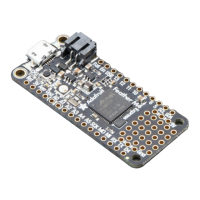Create the LED
The first thing we'll do is create the LED object. The NeoPixel object has two required arguments and two optional
arguments. You are required to set the pin you're using to drive your NeoPixels and provide the number of pixels you
intend to use. You can optionally set brightness and auto_write .
NeoPixels can be driven by any pin. We've chosen A1. To set the pin, assign the variable pixel_pin to the pin you'd
like to use, in our case board.A1 .
To provide the number of pixels, assign the variable num_pixels to the number of pixels you'd like to use. In this
example, we're using a strip of 8 .
We've chosen to set brightness=0.3 , or 30%.
pixels[i] = color
time.sleep(wait)
pixels.show()
time.sleep(0.5)
def rainbow_cycle(wait):
for j in range(255):
for i in range(num_pixels):
rc_index = (i * 256 // num_pixels) + j
pixels[i] = wheel(rc_index & 255)
pixels.show()
time.sleep(wait)
RED = (255, 0, 0)
YELLOW = (255, 150, 0)
GREEN = (0, 255, 0)
CYAN = (0, 255, 255)
BLUE = (0, 0, 255)
PURPLE = (180, 0, 255)
while True:
pixels.fill(RED)
pixels.show()
# Increase or decrease to change the speed of the solid color change.
time.sleep(1)
pixels.fill(GREEN)
pixels.show()
time.sleep(1)
pixels.fill(BLUE)
pixels.show()
time.sleep(1)
color_chase(RED, 0.1) # Increase the number to slow down the color chase
color_chase(YELLOW, 0.1)
color_chase(GREEN, 0.1)
color_chase(CYAN, 0.1)
color_chase(BLUE, 0.1)
color_chase(PURPLE, 0.1)
rainbow_cycle(0) # Increase the number to slow down the rainbow

